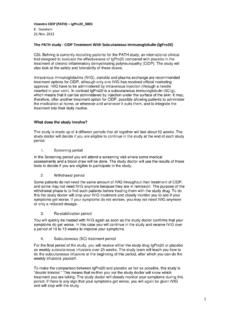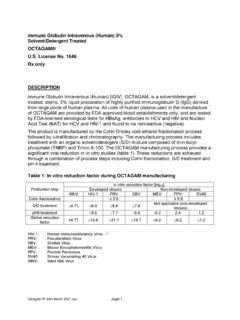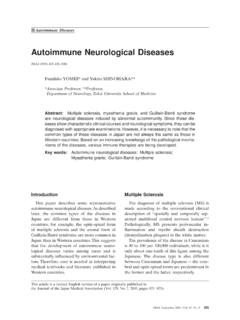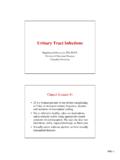Transcription of ANNEX I SUMMARY OF PRODUCT CHARACTERISTICS
1 1 ANNEX I SUMMARY OF PRODUCT CHARACTERISTICS 2 1. NAME OF THE MEDICINAL PRODUCT Cerezyme 200 U Powder for concentrate for solution for infusion Cerezyme 400 U Powder for concentrate for solution for infusion 2. QUALITATIVE AND QUANTITATIVE COMPOSITION Cerezyme 200 U powder for concentrate for solution for infusion Each vial contains 200 units* of imiglucerase**. After reconstitution, the solution contains 40 units (approximately mg) of imiglucerase per ml (200 U/5 ml). Cerezyme 400 U powder for concentrate for solution for infusion Each vial contains 400 units* of imiglucerase**. After reconstitution, the solution contains 40 units (approximately mg) of imiglucerase per ml (400 U/10 ml).
2 * An enzyme unit (U) is defined as the amount of enzyme that catalyses the hydrolysis of one micromole of the synthetic substrate para-nitrophenyl -D-glucopyranoside (pNP-Glc) per minute at 37 C. ** Imiglucerase is a modified form of human acid -glucosidase and is produced by recombinant DNA technology using a mammalian Chinese Hamster Ovary (CHO) cell culture, with mannose modification for targeting macrophages. Excipients: For the full list of excipients, see section Cerezyme 200 U powder for concentrate for solution for infusion This medicinal PRODUCT contains sodium and is administered in sodium chloride intravenous solution (see section ).
3 After reconstitution, the solution contains mmol sodium (200 U/5 mL). To be taken into consideration by patients on a controlled sodium diet. Cerezyme 400 U powder for concentrate for solution for infusion This medicinal PRODUCT contains sodium and is administered in sodium chloride intravenous solution (see section ). After reconstitution, the solution contains mmol sodium (400 U/10 mL). To be taken into consideration by patients on a controlled sodium diet. 3. PHARMACEUTICAL FORM Powder for concentrate for solution for infusion. Cerezyme is a white to off-white powder. 4. CLINICAL PARTICULARS Therapeutic indications Cerezyme (imiglucerase) is indicated for use as long-term enzyme replacement therapy in patients with a confirmed diagnosis of non-neuronopathic (Type 1) or chronic neuronopathic (Type 3) Gaucher disease who exhibit clinically significant non-neurological manifestations of the disease.
4 3 The non-neurological manifestations of Gaucher disease include one or more of the following conditions: anaemia after exclusion of other causes, such as iron deficiency thrombocytopenia bone disease after exclusion of other causes such as Vitamin D deficiency hepatomegaly or splenomegaly Posology and method of administration Disease management should be directed by physicians knowledgeable in the treatment of Gaucher disease. Posology Due to the heterogeneity and the multi-systemic nature of Gaucher disease, dosage should be individualised for each patient based on a comprehensive evaluation of all clinical manifestations of the disease.
5 Once individual patient response for all relevant clinical manifestations is well-established, dosages and frequency of administration may be adjusted with the goal to either maintain already reached optimal parameters for all clinical manifestations or further improve those clinical parameters which have not yet been normalised. A range of dosage regimens has proven effective towards some or all of the non-neurological manifestations of the disease. Initial doses of 60 U/kg of body weight once every 2 weeks have shown improvement in haematological and visceral parameters within 6 months of therapy and continued use has either stopped progression of or improved bone disease.
6 Administration of doses as low as 15 U/kg of body weight once every 2 weeks has been shown to improve haematological parameters and organomegaly, but not bone parameters. The usual frequency of infusion is once every 2 weeks; this is the frequency of infusion for which the most data are available. Paediatric population No dose adjustment is necessary for the paediatric population. The efficacy of Cerezyme on neurological symptoms of chronic neuronopathic Gaucher patients has not been established and no special dosage regimen can be recommended for these manifestations (see section ). Method of administration After reconstitution and dilution, the preparation is administered by intravenous infusion.
7 At initial infusions, Cerezyme should be administered at a rate not exceeding unit per kg body weight per minute. At subsequent administrations, infusion rate may be increased but should not exceed 1 unit per kg body weight per minute. Infusion rate increases should occur under supervision of a health care professional. Infusion of Cerezyme at home may be considered for patients who are tolerating their infusions well for several Decision to have patient move to home infusion should be made after evaluation and recommendation by the treating physician. Infusion of Cerezyme by the patient or caregiver at home requires training by a health care professional in a clinical setting.
8 The patient or caregiver will be instructed in infusion technique and the keeping of a treatment diary. Patients experiencing adverse events during the infusion need to immediately stop the infusion process and seek the attention of a healthcare professional. Subsequent infusions may need to occur in a clinical setting. Dose and infusion rate should remain constant while at home, and not be changed without supervision of a health care professional. For instructions on reconstitution and dilution of the medicinal PRODUCT before administration, see section 4 Medical or healthcare professionals are encouraged to register Gaucher patients, including those with chronic neuronopathic manifestations of the disease, in the ICGG Gaucher Registry (see section ).
9 Contraindications Hypersensitivity to the active substance or to any of the excipients listed in section Special warnings and precautions for use Hypersensitivity Current data using a screening ELISA followed by a confirmatory radioimmunoprecipitation assay, suggest that, during the first year of therapy, IgG antibodies to imiglucerase are formed in approximately 15% of the treated patients. It appears that patients who will develop IgG antibody are most likely to do so within 6 months of treatment and will rarely develop antibodies to Cerezyme after 12 months of therapy. It is suggested that patients suspected of a decreased response to the treatment be monitored periodically for IgG antibody formation to imiglucerase.
10 Patients with antibody to imiglucerase have a higher risk of hypersensitivity reactions (see section ). If a patient experiences a reaction suggestive of hypersensitivity, subsequent testing for imiglucerase antibodies is advised. As with any intravenous protein PRODUCT , severe allergic-type hypersensitivity reactions are possible, but occur uncommonly. If these reactions occur, immediate discontinuation of the Cerezyme infusion is recommended and appropriate medical treatment should be initiated. The current medical standards for emergency treatment are to be observed. Patients who have developed antibodies or symptoms of hypersensitivity to Ceredase (alglucerase) should be treated with caution when administering Cerezyme (imiglucerase).

















![(See DOSAGE and ADMINISTRATION [2.4.], …](/cache/preview/9/e/3/e/9/3/6/8/thumb-9e3e936878209d5fde0ef15a4eba9055.jpg)